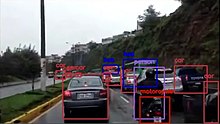Object detection
Object detection is a computer technology related to
Uses

It is widely used in
Often, the test images are sampled from a different data distribution, making the object detection task significantly more difficult.[5] To address the challenges caused by the domain gap between training and test data, many unsupervised domain adaptation approaches have been proposed.[5][6][7][8][9] A simple and straightforward solution of reducing the domain gap is to apply an image-to-image translation approach, such as cycle-GAN.[10] Among other uses, cross-domain object detection is applied in autonomous driving, where models can be trained on a vast amount of video game scenes, since the labels can be generated without manual labor.
Concept
Every object class has its own special features that help in classifying the class – for example all circles are round. Object class detection uses these special features. For example, when looking for circles, objects that are at a particular distance from a point (i.e. the center) are sought. Similarly, when looking for squares, objects that are perpendicular at corners and have equal side lengths are needed. A similar approach is used for face identification where eyes, nose, and lips can be found and features like skin color and distance between eyes can be found.
Methods
Methods for object detection generally fall into either neural network-based or non-neural approaches. For non-neural approaches, it becomes necessary to first define features using one of the methods below, then using a technique such as support vector machine (SVM) to do the classification. On the other hand, neural techniques are able to do end-to-end object detection without specifically defining features, and are typically based on convolutional neural networks (CNN).
- Non-neural approaches:
- Neural network approaches:
See also
- Feature detection (computer vision)
- Moving object detection
- Small object detection
- Outline of object recognition
- Teknomo–Fernandez algorithm
References
- ^ Dasiopoulou, Stamatia, et al. "Knowledge-assisted semantic video object detection." IEEE Transactions on Circuits and Systems for Video Technology 15.10 (2005): 1210–1224.
- ISBN 978-1-4398-3087-1.
- S2CID 233194604.
- ^ Wu, Jianxin, et al. "A scalable approach to activity recognition based on object use." 2007 IEEE 11th international conference on computer vision. IEEE, 2007.
- ^ arXiv:2105.13502 [cs.CV].
- arXiv:1904.02361 [cs.LG].
- S2CID 208138033.
- S2CID 253251380.
- arXiv:2208.14662 [cs.CV].
- arXiv:1703.10593 [cs.CV].
- ISBN 1492671207.)
{{cite book}}: CS1 maint: multiple names: authors list (link - ^ Dalal, Navneet (2005). "Histograms of oriented gradients for human detection" (PDF). Computer Vision and Pattern Recognition. 1.
- S2CID 215827080.
- Bibcode:2015arXiv150408083G.
- arXiv:1506.01497.
- ^ arXiv:1904.02701v1 [cs.CV].
- S2CID 2141740.
- Bibcode:2017arXiv171106897Z.
- S2CID 47252984.
- arXiv:1811.11168 [cs.CV].
- arXiv:1703.06211 [cs.CV].
- "Object Class Detection". Vision.eecs.ucf.edu. Archived from the original on 2013-07-14. Retrieved 2013-10-09.
- "ETHZ – Computer Vision Lab: Publications". Vision.ee.ethz.ch. Archived from the original on 2013-06-03. Retrieved 2013-10-09.
